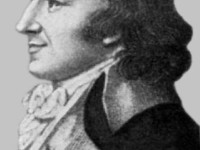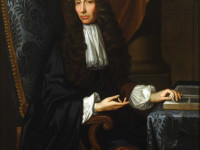
Jöns Jacob Berzelius (1779 – 1848)
On August 20, 1779, Swedish chemist Jöns Jacob Berzelius was born. Berzelius is considered, along with Robert Boyle, John Dalton, and Antoine Lavoisier, to be one of the founders of modern chemistry. In Sweden, Berzelius Day is celebrated on 20 August in honor of him.
“Every chemical combination is wholly and solely dependent on two opposing forces, positive and negative electricity, and every chemical compound must be composed of two parts combined by the agency of their electrochemical reaction, since there is no third force. Hence it follows that every compound body, whatever the number of its constituents, can be divided into two parts, one of which is positively and the other negatively electrical.”
– Jöns Jacob Berzelius Essai sur la théorie des proportions chemiques (1819)
Jöns Jacob Berzelius – Background
Jöns Jacob Berzelius was born in 1779 the son of Samuel Berzelius, a priest and teacher, who died of tuberculosis when Jöns was only four years old. In 1785 his mother Anna Christina married the priest Anders Ekmarck from Norrköping, to whom Berzelius attested in his autobiography an exemplary character and who awakened in him the love for nature (botany). Jöns Jakob Berzelius was first educated by tutors. From 1793 he attended grammar school in Linköping. As he was also exposed to the rough treatment of his cousins here, he took a job as a tutor at Norrköping for one year (1794/95), where he deepened his enthusiasm for nature studies with the help of his old tutor.
His medical studies started in 1796 in Uppsala because this field of study was quite close to natural sciences and most likely provided a decent income. He studied under Anders Gustav Ekeberg, the chemist who discovered tantalum. Berzelius received his candidate and licentiate degree in 1801. His dissertation, entitled Effects of Galvanic Electricity on Patients, which he had already submitted in 1801, appeared in 1802. He did not earn his doctorate in medicine until 1804. After Berzelius left the university, his uncle organized him a job as a pharmacist. While in medical school at the University of Uppsala, Berzelius was fascinated about Alessandro Volta’s “electric pile” [4] and while working at the Medevi mineral springs, a spa and health resort, Berzelius constructed one for himself from 60 zinc plates and 60 copper plates. His thesis for his medical degree was on the effect of electric shock on patients with various diseases, for instance paralysis. Even though he reported no improvement in his patients, his interest in electrochemical topics continued.
The Birth of Modern Chemistry
In 1802, Berzelius became an unpaid assistant at the Surgical Institute in Stockholm (Karolinska Institute since 1810). Since he had hardly any income at the beginning, he lived with the mineral water entrepreneur Lars Gabriel Werner, for whom he carried out studies as compensation for food and lodging. Berzelius had no laboratory at the Surgical Institute. However, the mine owner Wilhelm Hisinger, who also experimented himself, provided him with laboratories in which he could carry out the first internationally renowned experiments. In 1805 he became an unrelated assessor because his application to succeed Anders Sparrman was unsuccessful. At the same time he became a poor doctor in the eastern part of Stockholm, which he remained until 1810. In 1806, due to the sudden death of Sparrman’s successor, he was appointed paid editor of chemistry.
Berzelius assumed that atom groups would behave like small magnets. A particle could react electropositively, electronegatively or unipolarly in a volt pocket column. Berzelius assumed that all salts – inorganic and organic – would consist of a positive and a negative pole and were small molecular magnets. In an electropositive molecule magnet, the positive charge outweighs the negative charge in an electronegative particle. According to his theory, potassium sulfate consisted of the electropositively charged particles KO and the electronegatively charged SO3, Berzelius’ publication on electrochemistry also influenced Humphry Davy[5], who successfully conducted electrochemical experiments in 1806, which, to Berzelius’s disappointment, earned him much higher recognition.
Oxygen was the most negative element for Berzelius; all elements connected to the oxygen had to have an electropositive charge. Some elements such as sulphur could sometimes be electropositive as well as electronegative (in sulphur dioxide the sulphur is electropositive, as metal sulphide electronegative). He sorted the elements into a voltage series. For Berzelius, electronegative oxygen was the linchpin of his further experiments. The most important position of oxygen was its ability to produce easily determinable compounds with metals and, moreover, all acids and bases known at that time contained oxygen. Davy was the first acid without oxygen, hydrochloric acid. Berzelius arbitrarily gave the oxygen the atomic mass 100 and related all other atomic masses to the oxygen. Later he also chose hydrogen as his reference point.
Organic Chemistry
Berzelius was the first person to make the distinction between organic compounds (those containing carbon), and inorganic compounds. In particular, he advised Gerardus Johannes Mulder in his elemental analyses of organic compounds such as coffee, tea, and various proteins. The term protein itself was coined by Berzelius, after Mulder observed that all proteins seemed to have the same empirical formula and came to the erroneous conclusion that they might be composed of a single type of very large molecule. The term is derived from the Greek, meaning “of the first rank”, and Berzelius proposed the name because proteins were so fundamental to living organisms. In 1808, Berzelius discovered that lactic acid occurs in muscle tissue, not just in milk. He also determined that lactic acid occurs in two different optical isomers
Academic Career
In 1807 he was made a professor at the Medical College in Stockholm, which soon after became the Karolinsska Institute. A year later he began his long association with the Royal Swedish Academy of Sciences [1,3]. In 1812 he was able to undertake his first study trip to England. In 1817 Berzelius was appointed to the University of Berlin as successor to Martin Heinrich Klaproth, which he rejected. 1818-1819 Berzelius spent one year in Paris, where he met numerous important chemists. He was also raised to the nobility in 1818. In 1822 he was elected to the American Academy of Arts and Sciences. In 1832 he resigned as professor.
Berzelius intended to create a textbook for his medical students and performed a series of experiments which made him most famous. With these experiments, he managed to establish that the elements in inorganic substances are bound together in definite proportions by weight. His increasing interest in all kinds of compounds led to his discovery of numerous elements, such as cerium, selenium, and thorium. Selenium was named after the moon goddess selene by Berzelius [3]. Also, several students worked together with the scientist and discovered several elements as well, including lithium and vanadium. Berzelius was then able to determine the atomic weight of almost all elements and he was motivated to create a logical system of symbols (H, Cl, Ca …) [1,2].
Jöns Jacob Berzelius received 12 royal orders and was member of almost 100 academies and scientific societies around the globe. He was elevated to the nobility in 1818 and awarded the baronetcy in 1835. The scientist, who is on this day considered as one of the founders of modern chemistry suffered a seizure that paralyzed his legs in 1847. Jöns Jacob Berzelius died in Stockholm on 7 August 1848 and was buried in Solna. [3].
J. Michael McBride, 21. Berzelius to Liebig and Wöhler (1805-1832), [7]
References and Further Reading:
- [1] Jöns Jacob Berzelius at the Chemical Heritage Foundation
- [2] Jöns Jacob Berzelius – the man who invented catalysis?
- [3] Jöns Jacob Berzelius A Guide to the Perplexed Chemist
- [4] Alessandro Volta and the Electricity, SciHi Blog
- [5] Humphry Davy and the Electrolysis, SciHi Blog
- [6] Jöns Jacob Berzelius at Wikidata
- [7] J. Michael McBride, 21. Berzelius to Liebig and Wöhler (1805-1832), Freshman Organic Chemistry (CHEM 125), 2009, YaleCourses @ youtube
- [8] . The American Cyclopædia. 1879.
- [9] Online correspondence between Berzelius and Sir Humphry Davy on Wikisource (in English and French)
- [10] Works by or about Jöns Jacob Berzelius at Internet Archive
- [11] Marshall, James L.; Marshall, Virginia R. “Rediscovery of the Elements: Jöns Jacob Berzelius”. chem.unt.edu. University of North Texas Department of Chemistry.
- [12] Berzelius, Jacob (1813), Thomson, Thomas (ed.), “Essay on the Cause of Chemical Proportions, and on some Circumstances relating to them: together with a short and easy Method of expressing them”, Annals of Philosophy, London: Robert Baldwin, vol. II & III, pp. 51–62, 93–106, 244–256, 353–364, 443–454
- [13] “Jöns Jakob Berzelius (1779–1848)”. Nature. 162 (4110): 210. 1948.
- [14] Timeline for Jöns Jacob Berzelius, via Wikidata






Pingback: Whewell’s Gazette: Year 2, Vol. #06 | Whewell's Ghost